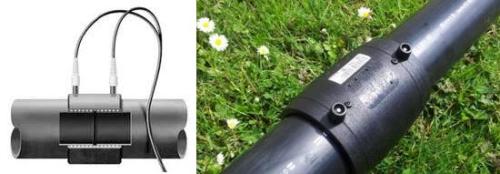To create any PE pipelines, it is necessary to fasten the pipes to each other. In order to facilitate this task, our article presents the technology of welding polyethylene pipes. Such pipes can be connected using the butt method or electrofusion welding. Both welded and electric-welded fastening of polyethylene pipes is strong enough, has the necessary tightness and resistance to destructive external influences throughout the entire service life of the pipeline.
If you are more interested in the equipment necessary for this, we recommend that you read the article "".
Preparation of equipment for welding
The process of welding low-pressure polyethylene pipes consists of preparatory measures (they are identical for all types of welding machines), welding itself and final operations. Preparation for welding:
- A site is being set up where welding will take place, welding equipment is placed on it.
- All necessary pipes, fittings and other connecting elements are prepared.

- Pipes and fittings (fittings) are connected and centered.
- Processing of the ends of pipes and parts is carried out mechanically.
Pro tip:
The preparatory operations of the welding machine must be carried out with high quality, with strict adherence to the instructions of the equipment manufacturer. Then the welding machine will last a long time, performing welding work in the best possible way. It is advisable to enter data on equipment checks in the production work log.
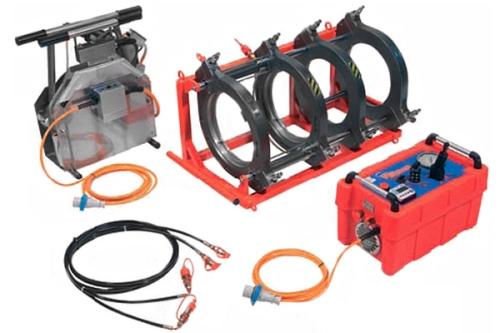
The welding machine is located in a specially organized place, freed from foreign objects, where polyethylene pipes have been previously delivered. Before starting work, before connecting the equipment to the mains, it must be inspected and prepared:
- visual inspection of the units of the welding machine;
- checking the insulation of electrical wires and grounding conductors;
- refueling the electric generator with fuel and testing its operability by control switching on;
- determination of the oil level in the hydraulic system of the welding machine;
- test of serviceability of a mobile clamp;
- checking the degree of sharpening of the trimmer knives;
- diagnostics of instrumentation;
- preparation of clamps and reducing inserts, which are required for welding pipes of the existing diameter;
- lubrication of rubbing joints and surfaces of welding equipment with compositions recommended by the equipment manufacturer;
- cleaning the heater, trimmer and scraper from dirt and traces of polyethylene, degreasing surfaces with a cotton cloth moistened with a solvent.
Polyethylene pipe welding technology
Butt Welding Process
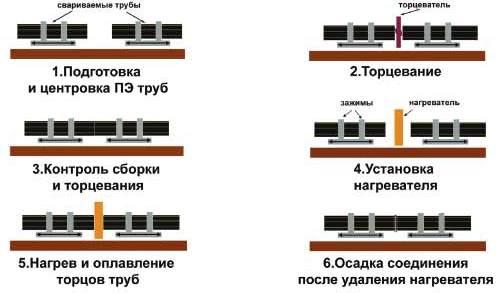
By means of the heating element of the welding machine, the ends of the pipes or welded parts are heated to the viscous state of polyethylene. Next, the heater is removed, and the ends are connected under pressure.
The technology of welding polyethylene pipes consists of several stages:
- melting of pipes and fittings - upon completion of the process, primary burr is formed;
- heating the ends of the parts to a certain temperature - the thermal effect penetrates deep into the material, while the pressure is almost zero, because it is only necessary to ensure contact between the heating element and the ends of the pipes;
- technological pause (removal of the heater) - the heating element of the apparatus is removed from the welding zone, after which the joining of the surfaces to be welded follows;
Pro tip:
The technological pause during welding of PE pipes by the butt method should be as short as possible in order to exclude a decrease in the temperature of the ends of the welded parts, as well as to prevent the ingress of dust and contaminants that adversely affect the quality of the finished joint.
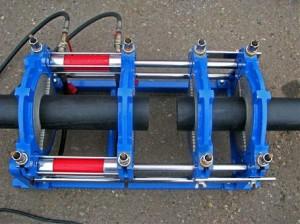
- butt welding - during welding, the final flash is formed, as well as molecular bonds that determine the uniformity and strength of the joint;
- cooling - provides a draft of the joint, which at the same time acquires maximum strength, the stage is needed to prevent the formation of stresses or shocks that can compromise the strength of the weld.
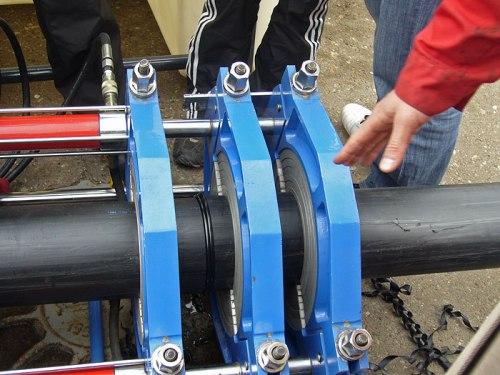
Welding process with electric couplings
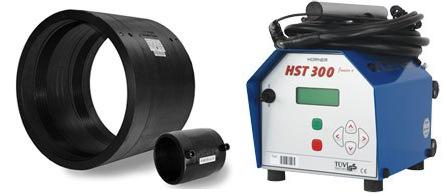
Welding of polyethylene pipes is also possible with the help of parts with an electric spiral. How to weld polyethylene pipes by laying an electric heater is described below.
In the parts that need to be connected by welding, a metal wire is laid in the form of a spiral. The welding unit heats and melts polyethylene in places where the elements will be connected - couplings, transitions, bends, etc. This is possible due to the release of heat, which is generated as a result of the flow of electric current through the spirals. After welding of the elements, natural cooling follows. Welding with embedded electric heaters is based on the phenomenon of diffusion, that is, on the mutual penetration of the molecules of the contacting surfaces into each other when they are heated. After cooling of the connected elements, a strong, strong weld is obtained.
